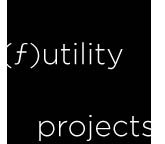About Us
Hi, we’re an installation group.
(ƒ)utility
In mathematics, a function is a relation between a given set of elements (the domain) and another set of elements (the codomain), which associates each element in the domain with exactly one element in the codomain. The elements so related can be any kind of thing (words, objects, qualities) but are typically mathematical quantities, such as real numbers.
What is intrinsic to the idea of a space? What is its central function? What has the function of a space historically been? What makes it visually distinct? Which way is a space oriented along the compass, and what are its defining trajectories of movement, light, and use? Spaces have a life unto themselves: a pre-existing set of defining contextual, spatial, and architectural parameters. The (ƒ)utility projects collaborative responds to these parameters through highly contextually contingent site-specific installations.
Each piece we create is based on the particular characteristics of the spaces we are invited to engage; (ƒ)utility projects’ methodology therefore begins with close observational study and research. Our approach is comprehensive. Every aspect of each space is addressed: from floor to ceiling to lighting and beyond, (ƒ)utility projects is invested in a seamless visual experience. This priority has led us to embrace emerging technologies: we have modeled our installations in Rhinoceros (a popular 3-d modeling program), made extensive use of laser-cutting and large-format printing technology, and produced work on a computer-numerically-controlled (CNC) router. Through our carefully calculated, illusory perceptual ‘extensions’, ‘recreations’ or ‘inversions’ of spaces, we are interested in surprising our viewers and in challenging any pre-existent expectations they may bring to a site.
About (ƒ)utility projects
Begun in summer 2009 as an offshoot of Drawing Studio: Articulating Space, a course at The School of the Art Institute of Chicago, (ƒ)utility projects consists of Paola Cabal, Michael Genge, a 2011 alumnus from SAIC’s Architecture and Design program as well as a motorcycle and bicycle gearhead, and Christopher Grieshaber, who wears multiple hats in the arts and construction worlds. The group forged its working paradigm over the course of two major installations in the pedway open studio, a Department of Cultural Affairs Public Art Program space below the Chicago Cultural Center. (ƒ)utility Projects officially debuted on March 19, 2010 with an exhibition at SubCity projects. They have since presented on their integration of electronic visualization and digital production methods at the 2010 “Vers10n” festival, in addition to designing an exhibition pavilion/intervention for Vers10n. (ƒ)utility projects was awarded a CAAP grant from the City of Chicago Department of Cultural Affairs in retroactive support of their debut project. In a 2011 exhibition titled “CoLaboratory” , (ƒ)utility projects exhibited alongside the collaborative EDJR at Columbia College Chicago’s Glass Curtain Gallery. In the summer of 2013, they installed “Boundary Transactions” at The Franklin in East Garfield Park and last year, they made “Reestablish Return”, an anamorphic sculptural intervention for Terrain South in Oak Park. The piece for the Riverside Art Center will be their 9th as a collaborative.
About our Members



